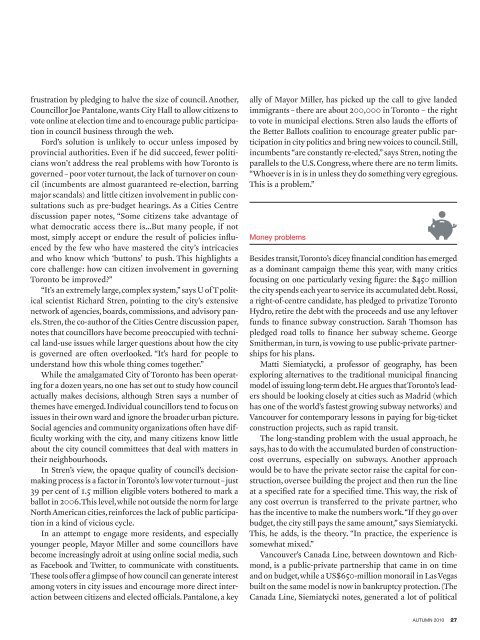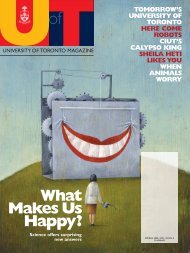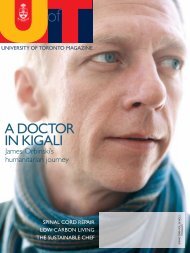You also want an ePaper? Increase the reach of your titles
YUMPU automatically turns print PDFs into web optimized ePapers that Google loves.
frustration by pledging to halve the size <strong>of</strong> council. Another,Councillor Joe Pantalone, wants City Hall to allow citizens tovote online at election time and to encourage public participationin council business through the web.Ford’s solution is unlikely to occur unless imposed byprovincial authorities. Even if he did succeed, fewer politicianswon’t address the real problems with how <strong>Toronto</strong> isgoverned – poor voter turnout, the lack <strong>of</strong> turnover on council(incumbents are almost guaranteed re-election, barringmajor scandals) and little citizen involvement in public consultationssuch as pre-budget hearings. As a Cities Centrediscussion paper notes, “Some citizens take advantage <strong>of</strong>what democratic access there is…But many people, if notmost, simply accept or endure the result <strong>of</strong> policies influencedby the few who have mastered the city’s intricaciesand who know which ‘buttons’ to push. This highlights acore challenge: how can citizen involvement in governing<strong>Toronto</strong> be improved?”“It’s an extremely large, complex system,” says U <strong>of</strong> T politicalscientist Richard Stren, pointing to the city’s extensivenetwork <strong>of</strong> agencies, boards, commissions, and advisory panels.Stren, the co-author <strong>of</strong> the Cities Centre discussion paper,notes that councillors have become preoccupied with technicalland-use issues while larger questions about how the cityis governed are <strong>of</strong>ten overlooked. “It’s hard for people tounderstand how this whole thing comes together.”While the amalgamated City <strong>of</strong> <strong>Toronto</strong> has been operatingfor a dozen years, no one has set out to study how councilactually makes decisions, although Stren says a number <strong>of</strong>themes have emerged. Individual councillors tend to focus onissues in their own ward and ignore the broader urban picture.Social agencies and community organizations <strong>of</strong>ten have difficultyworking with the city, and many citizens know littleabout the city council committees that deal with matters intheir neighbourhoods.In Stren’s view, the opaque quality <strong>of</strong> council’s decisionmakingprocess is a factor in <strong>Toronto</strong>’s low voter turnout – just39 per cent <strong>of</strong> 1.5 million eligible voters bothered to mark aballot in 2006. This level, while not outside the norm for largeNorth American cities, reinforces the lack <strong>of</strong> public participationin a kind <strong>of</strong> vicious cycle.In an attempt to engage more residents, and especiallyyounger people, Mayor Miller and some councillors havebecome increasingly adroit at using online social media, suchas Facebook and Twitter, to communicate with constituents.These tools <strong>of</strong>fer a glimpse <strong>of</strong> how council can generate interestamong voters in city issues and encourage more direct interactionbetween citizens and elected <strong>of</strong>ficials. Pantalone, a keyally <strong>of</strong> Mayor Miller, has picked up the call to give landedimmigrants – there are about 200,000 in <strong>Toronto</strong> − the rightto vote in municipal elections. Stren also lauds the efforts <strong>of</strong>the Better Ballots coalition to encourage greater public participationin city politics and bring new voices to council. Still,incumbents “are constantly re-elected,” says Stren, noting theparallels to the U.S. Congress, where there are no term limits.“Whoever is in is in unless they do something very egregious.This is a problem.”Money problemsBesides transit, <strong>Toronto</strong>’s dicey financial condition has emergedas a dominant campaign theme this year, with many criticsfocusing on one particularly vexing figure: the $450 millionthe city spends each year to service its accumulated debt. Rossi,a right-<strong>of</strong>-centre candidate, has pledged to privatize <strong>Toronto</strong>Hydro, retire the debt with the proceeds and use any leftoverfunds to finance subway construction. Sarah Thomson haspledged road tolls to finance her subway scheme. GeorgeSmitherman, in turn, is vowing to use public-private partnershipsfor his plans.Matti Siemiatycki, a pr<strong>of</strong>essor <strong>of</strong> geography, has beenexploring alternatives to the traditional municipal financingmodel <strong>of</strong> issuing long-term debt. He argues that <strong>Toronto</strong>’s leadersshould be looking closely at cities such as Madrid (whichhas one <strong>of</strong> the world’s fastest growing subway networks) andVancouver for contemporary lessons in paying for big-ticketconstruction projects, such as rapid transit.The long-standing problem with the usual approach, hesays, has to do with the accumulated burden <strong>of</strong> constructioncostoverruns, especially on subways. Another approachwould be to have the private sector raise the capital for construction,oversee building the project and then run the lineat a specified rate for a specified time. This way, the risk <strong>of</strong>any cost overrun is transferred to the private partner, whohas the incentive to make the numbers work. “If they go overbudget, the city still pays the same amount,” says Siemiatycki.This, he adds, is the theory. “In practice, the experience issomewhat mixed.”Vancouver’s Canada Line, between downtown and Richmond,is a public-private partnership that came in on timeand on budget, while a US$650-million monorail in Las Vegasbuilt on the same model is now in bankruptcy protection. (TheCanada Line, Siemiatycki notes, generated a lot <strong>of</strong> politicalautumn 2010 27
















